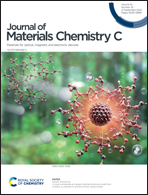Establishing design strategies for emissive materials with an inverted singlet–triplet energy gap (INVEST): a computational perspective on how symmetry rules the interplay between triplet harvesting and light emission†
Abstract
The inversion of the lowest singlet and triplet excited state energy gaps, in fully organic triangle-based compounds, can give rise to new exergonic pathways to enhance the performance of organic light-emitting diodes (OLEDs), going beyond the novel yet promising thermally activated delayed fluorescence (TADF) mechanism. The origin of this inversion, arises from the interplay between exchange and electron correlation effects and has been extensively investigated in the last few years, using wavefunction-based methods. However, a proper picture of the structure–property relationships characterizing these systems is still lacking. In this study, we thus assessed the effect of different symmetry point groups (D3h, C2v, C3h and C3v) on the orbital localization to shed light on the role played by symmetry in determining the optical features of the triangulene systems (on both S1–T1 inversion and oscillator strengths). The presence of the C2 axis and σv plane (as in the D3h, C2v and C3v groups) turned out to be critical for ensuring proper orbital localization aimed at minimizing exchange interaction, therefore favouring the inversion process. In particular, adopting the C2v (and its subgroups) symmetry through a proper doping pattern of the triangulene core, by introducing substituents or by merging two triangulene cores, is the only way to achieve a negative ΔEST and a non-zero oscillator strength. Finally, we summarized the lessons learnt from this analysis to establish a series of design rules aimed at helping the identification of inverted singlet–triplet (INVEST) emitters for applications in next-generation OLEDs.



 Please wait while we load your content...
Please wait while we load your content...